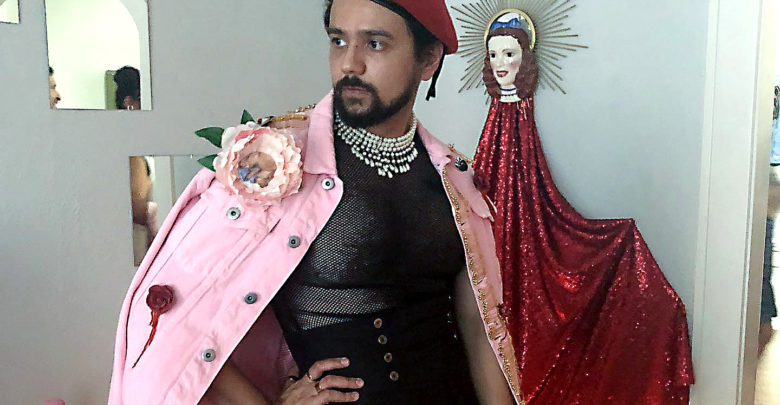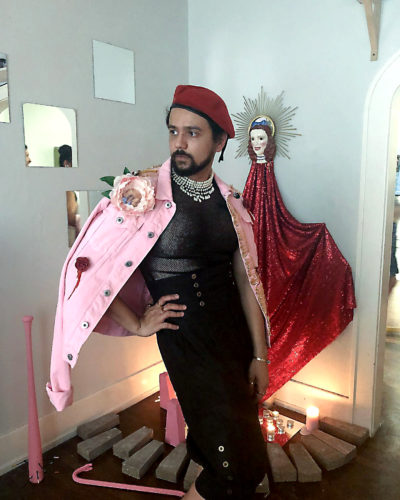
Art with a Global Perspective
Artist Philip Karjeker depicts queer complexity.

In quintessential Houston style, Philip Karjeker has energized the queer arts community here with his global perspective, informed art-making practice, and his richly multicultural background. He is a cofounder of the gay multigenerational arts think tank Qollective, with recent exhibitions at G Spot Gallery and Alabama Song. Karjeker’s voice is both matter-of-fact (with its images reflecting the daily realities of gay men’s lives) yet also able to engage with the grander mythic iconography of queer images.
Karjeker was born in Philadelphia in 1991, shortly before his family moved to Texas. His father is Indian and Cape Malay, the latter being a hybrid Muslim identity out of Capetown, South Africa. His mother can claim Russian, Jewish, and Filipino ancestry. Karjeker was raised Jewish by a mother who liked art and a father who preferred debating politics.
Karjeker’s complex professional biography helps account for the many different influences that inform his art. He first studied the history of art at the University of Texas in Austin as an undergrad. Then queer art inspired him to write his honors thesis on Robert Rauschenberg’s early work, based on the album of Carmen Jones. Karjeker then aimed for a life in museum work, and enjoyed a summer abroad in Tuscany before attending the Sotheby’s Institute in London to study the visual-arts business, including intellectual property law. He then lived in Barcelona to work with antique furniture before moving to New York to work as a gallery guide at the Guggenheim Museum in 2016.
Two shows he got to explicate for visitors were those of the Italian artist Alberto Burri and the Swiss collaborative team Fischli/Weiss. Burri was a mid-century European master famous for memorial paintings with burnt surfaces evoking Europe’s post-World War II devastation. Fischli and Weiss are conceptual pranksters known for their laugh-out-loud results. Both are clear influences on Karjeker’s sensibility.
Karjeker recalls with amusement his encounter with film-celebrity John Waters, who visited an exhibit and told Karjeker to “f–k off” when Karjeker told Waters how much he loves Waters’ camp-classic Pink Flamingos—only to realize much later that no director wants to hear that their earliest film experiments are still the ones most loved by the general public.

Surviving in New York is always tough on young artists, so after three particularly lean months Karjeker returned to the more-affordable Houston and its supportive art world. He had come out in his teens to his high-school art teachers in Clear Lake, and never considered himself to be closeted. The art he made when he first returned home was a series of joyful abstractions resembling the glorious Kandinsky paintings that he saw during his time at the Guggenheim.
Karjeker’s desire to make beautiful paintings, and his critical eye in studying cultural artifacts that reflect his hybrid identity, led to a series of works that have established his reputation as one of the foremost queer image-makers in Texas. Individual objects are adoringly presented on either gold, royal blue, or rainbow grounds. While he is not formally trained in the tradition of Indian miniature painting, it’s hard to not think of these bejeweled wonders when looking at his work. His love of cartoons and anime is equally apparent.
Karjeker’s gay Jewish persona is seen in a beautifully described study of a loaf of challah bread. Another work shows the iconic cartoon scene with Bugs Bunny in drag as Wagner’s Brünnhilde. That animated masterpiece turned a whole generation of gay men on to both drag and opera. (When that cartoon was shown at G Spot Gallery, scores of gay men over 50 shared their stories of seeing this cartoon as kids and being forever changed by it.)
In the Stonewall 50/50 exhibition that I curated in New York City this summer, I included two works by Karjeker. One was a shrine to poppers on a gold ground that reflected the artist’s interest in the type of sexual license that is implied by visibly carrying poppers. The piece is called Socrates Swallowed Hemlock (2018) and ambivalently evokes an historical moment of valiant queer self-sacrifice. Karjeker notes that if Socrates was indeed found guilty of corrupting the youth of Athens, the poppers similarly “corrupted” the artist by vanquishing his once-conservative views on acceptable sexual expression.
Karjeker’s second work from Stonewall 50/50 is entitled Cupid and Psyche (2019), in which two Truvada pills nestle in the middle of a gold circle. If the poppers relate to the artist’s exploration of anal pleasure, the adoring representation of Truvada as PrEP treatment conjures a whole generation’s gratitude for the reclaimed sexual pleasures that had been banished for three decades.
Yet as much as Karjeker is by and large a celebratory image maker, tragedy appears in his profoundly moving Pulse memorial work, titled simply June 12, 2016. Small gold triangles mark the death of each victim who was killed in the Pulse nightclub massacre. In its joyful colors and subtlety, the painting serves to remind us that our greatest sorrows are interwoven with our most resonant pleasures.
This article appears in the July 2019 edition of OutSmart magazine.










